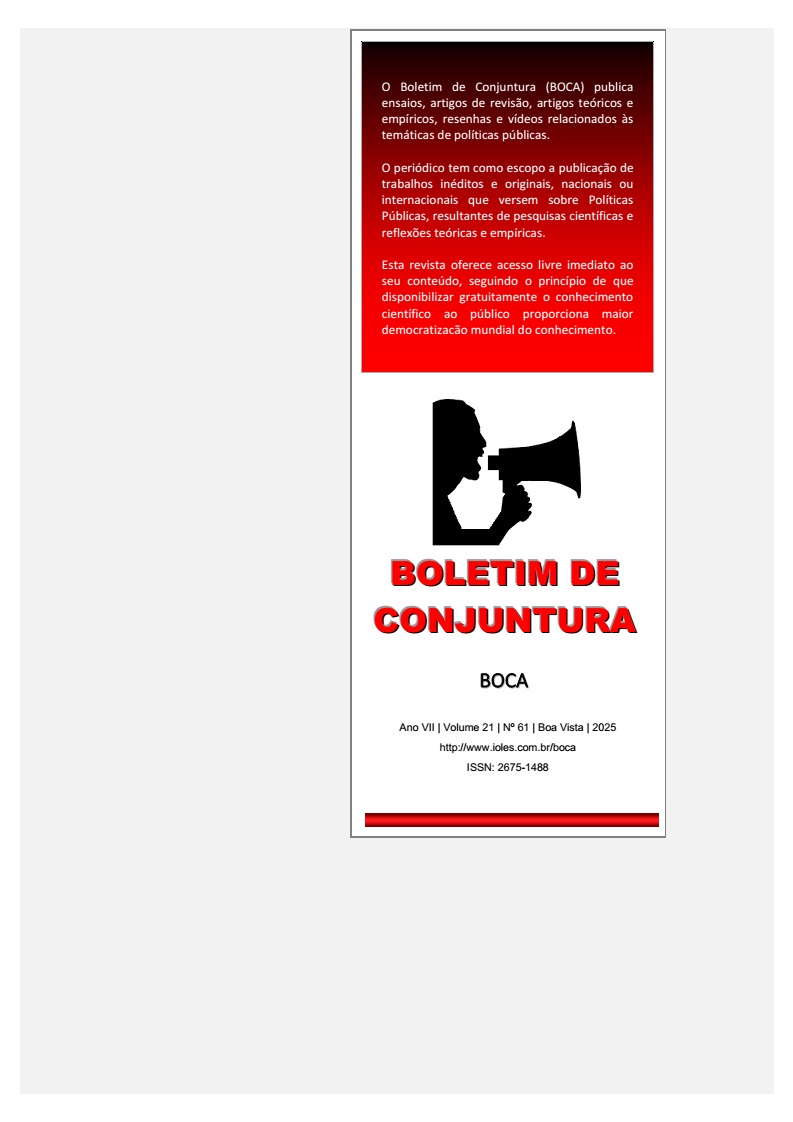PREVALENCE OF THE HIV VIRUS IN PREGNANT WOMEN IN THE STATE OF PARAÍBA (2020-2024)
Main Article Content
Abstract
The prevalence of HIV (Human Immunodeficiency Virus) is lower among women compared to men. However, in many cases, the diagnosis in women occurs during pregnancy, generally after prenatal examinations. The present study aims to describe the prevalence of HIV cases in pregnant women in the state of Paraíba from 2020 to 2024. It is an exploratory, descriptive and retrospective epidemiological study. Data were collected from DATASUS (Informatics Department of the Unified Health System), tabulated in Microsoft Excel and analyzed with the aid of Jamovi software, using a prevalence equation. The results indicated a prevalence of 0.13%, corresponding to 551 absolute cases. Among the registered cases, 90% of diagnoses occurred during prenatal care, reinforcing the importance of periodic testing as an essential strategy to prevent vertical transmission. The data point to a reduction in the number of HIV cases in pregnant women throughout the analyzed period, with a tendency towards stabilization. This result highlights the relevance of starting prenatal care early and carrying out tests in the three trimesters of pregnancy. These measures increase the likelihood of early detection of HIV, allowing for timely interventions, such as initiation of treatment and prophylaxis for the newborn, significantly reducing the risk of congenital transmission. The prevalence of HIV in pregnant women in the state has demonstrated stability with a tendency to decrease in the last 2 years, making studies and constant monitoring necessary to reduce these cases during the gestational period.
Article Details

This work is licensed under a Creative Commons Attribution 4.0 International License.
Copyright (c). Conjuncture Bulletin (BOCA)
This work is licensed under a Creative Commons Attribution 4.0 International License.
References
AFRASHTEH, S. et al. “Factors associated with late antiretroviral therapy initiation among people living with HIV in southern Iran: a historical cohort study”. Frontiers in Public Health, vol. 10, 2022.
BOGDANIĆ, N. et al. “Timeliness of antiretroviral therapy initiation in the era before universal treatment”. Scientific Reports, vol. 1, n. 11, 2021.
BRASIL. Portaria GMS/MS n. 217, de 1 de março de 2023. Brasília: Ministério da Saúde, 2023. Disponível em: . Acesso em: 27/12/2024.
BUSSAB, W. O. Estatística Básica. São Paulo: Editora Saraiva, 2017.
CARMO, R. A. et al. “Subnotificação de óbitos por AIDS no Brasil: Linkage dos registros hospitalares com dados de declaração de óbito”. Ciência e Saúde Coletiva, vol. 4, n. 26, 2021.
CORNELIA, M. D. et al. “Arthrocentesis, arthroscopy or arthrotomy for septic knee arthritis in children: A systematic review”. Journal of Children's Orthopaedics, vol. 15, n. 1, 2021.
CUNHA, A. P. et al. “Análise da tendência da mortalidade por HIV/AIDS segundo características sociodemográficas no Brasil, 2000 a 2018”. Ciência e Saúde Coletiva, vol. 27, 2022.
FARIAS, G. M. et al. “Prevalência das internações por aids em um hospital de referência no estado da Paraíba”. Boletim de Conjuntura (BOCA), vol. 20, n. 58, 2024.
FONSECA, A. B. et al. “Diagnóstico tardio de HIV na terceira idade: uma análise de reportagens veiculadas na mídia”. Revista psicologia, Diversidade e Saúde, vol. 9, n. 1, 2020.
GAMA, W. M. et al. “Immunologic biomarkers, morbidity and mortality among HIV patients hospitalised in a Tertiary Care Hospital in the Brazilian Amazon”. BMC Infectious Diseases, vol 21, n 2, 2021.
GUYO, A. G. et al. “Joint external evaluation of the international health regulations (2005) capacity in South Sudan: assessing the country’s capacity for health security”. The Pan African Medical Journal, vol. 42, n. 1, 2022.
LEPATOV, K. V. et al. “Septic arthritis of the hand: Current issues of etiology, pathogenesis, diagnosis, treatment”. World Journal of Orthopedics, vol. 13, n. 7, 2022.
LOPES, B. B. et al. “Epidemiology of HIV in pregnant women and its relationship with the period of the COVID-19 pandemic”. Revista da Escola de Enfermagem da USP, vol. 57, 2023.
MALABA T. R. et al. “Pregnancy outcomes in women living with HIV and HIV-negative women in South Africa: cohort analysis based on bias-corrected gestational age”. Paediatric and Perinatal Epidemiology, vol. 36, n. 4, 2022.
OLIVEIRA, E. V.; MARTINS, W. “Principais fatores do crescimento de hiv na terceira idade”. Boletim de Conjuntura (BOCA), vol. 6, n. 17, 2021.
PARAÍBA. Boletim Epidemiológico HIV/AIDS: “Cenário Epidemiológico no estado da Paraíba”. João Pessoa: Secretaria de Saúde do Estado da Paraíba, 2023. Disponível em: . Acesso em: 23/12/2024.
PAUL, S. et al. “Vulnerability to Sexually Transmitted Infections (STI) / Human Immunodeficiency Virus (HIV) among adolescent girls and young women in India: A rapid review”. PloS One, vol. 19, n. 2, 2024.
SANTANA, J. M. et al. “Perfil do coeficiente de letalidade por HIV/AIDS no estado da Paraíba em 2023”. Boletim de Conjuntura (BOCA), vol. 19, n. 57, 2024.
SOUZA, D. R. S. et al. “Association of adhesion to the cegonha network in Brazil with maternal mortality and other health indicators”. Revista Ciência Plural, vol. 8, n. 2, 2022.
SOUZA, R. O. Serviço Social na Saúde: Contribuições Políticas e profissionais ao Exercício do Controle Social (Dissertação de Mestrado em Serviço Social). Rio de Janeiro: UFRJ, 2001.
OMS – Organização Mundial da Saúde. “Global HIV and AIDS statistics—Fact sheet”. OMS [2023]. Available from: . Access in: 12/12/2024.
VENKATESH, K. K. et al. “Associations between HIV, antiretroviral therapy and preterm birth in the US Women’s Interagency HIV Study, 1995 a 2018: a prospective cohort”. HIV, vol. 23, n. 4, 2022.
VOSS, A. et al. “Post-operative septic arthritis after arthroscopy: modern diagnostic and therapeutic concepts. Knee Surgery”. Sports Traumatology, Arthroscopy, vol. 29, n. 10. 2021.
WANG, J.; WANG, L. “Novel therapeutic interventions towards improved management of septic arthritis”. BMC Musculoskeletal Disorders, vol. 22, n. 1, 2021.


